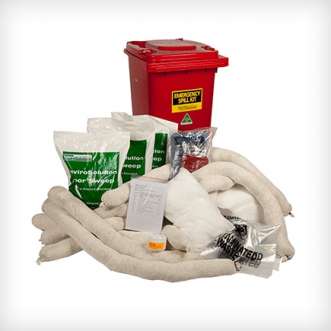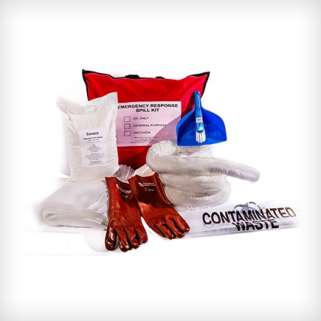Oil spill kits and fuel spill kits to clean-up hydrocarbon spills
What are oil and fuel spill kits?
 Oil and fuel spill kits are pre-packaged kits that contain everything needed to prevent a hydrocarbon spill from spreading, and to clean up the spill. Australian legislation requires certain sites to have spill kits available that are fully equipped and trained personnel who know what to do should a spill occur. For example, sites handling Class III flammable liquids are required by law to have spill kits available on site.
Oil and fuel spill kits are pre-packaged kits that contain everything needed to prevent a hydrocarbon spill from spreading, and to clean up the spill. Australian legislation requires certain sites to have spill kits available that are fully equipped and trained personnel who know what to do should a spill occur. For example, sites handling Class III flammable liquids are required by law to have spill kits available on site.
What do oil spill kits contain?
The contents of an oil and fuel spill kit can vary from site to site, depending on the specific material being handled. Different viscosity oils are treated in different ways, and spills of lighter products like gasoline can also ignite more easily. Spill response personnel must know what to do in each situation.
The following are standard items found in oil spill response kits:
- Hydrocarbon pads and pillows are made of absorbent material to soak up smaller spills and drips. Diverse types and grades of pad are available for cleaning up different hydrocarbons.
- Floor sweep is a product that is dusted over the spill area. Brooms and rakes are used to “work” the area until all the liquid has been absorbed. Enough floor sweep must be used so that the product does not become saturated.
- Plug and dike is a putty like product that is used to temporarily seal a leaking vessel. Sometimes, wooden wedges can be used too in order to make a seal.
- Contaminated waste bags are specially marked bags that indicate that the contents are contaminated with hydrocarbons. This is very important in terms of environmental legislation and also safe disposal of the waste. Some categories of waste can only be disposed of at certified waste disposal sites.
- PPE kit is the Personal Protective equipment that is needed by personnel involved in the clean-up operation. PPE can include coveralls, nitrile gloves, safety goggles and latex boot covers.
How do you replace items in oil spill kits?
SpillPro provides complete spill kits in their standard form or customised for the customer. When a spill occurs and some components of the kit are consumed, it is best to contact SpillPro directly who will send a serviceman to the site to replenish the kit. This will ensure that the contents remain compliant with legislation and complete to handle any spill that occurs.
What industries need to have oil spill kits?
Spill kits are essential environmental response equipment for a wide variety of industries:
Refineries and Industrial sites should have spill kits available in workshop areas and in each operational area. The quicker operators can respond to an incident and limit the spread of a spill, the easier the clean-up operation will be. Quick clean-up also reduces the risk of safety incidents like fire or explosion.
Workshops and automotive repair shops should have spill kits available to handle any accidental spill of oil or other fluids from equipment as it is being worked on. Pad and pillows can also be used to catch a drip if it is known that there is a risk of leakage in specific maintenance operations.
Shipping industries need specific oil spill kits that are equipped to handle spills on land and on the surface of water. Spills that contaminate water systems can spread quickly can cause significant environmental harm.
Mining service areas are another candidate for readily available oil spill kits as the harsh operating conditions of equipment may lead to unforeseen hydrocarbon spills and leaks.
How you would actually use an oil spill kit?
 An oil spill kit should be located in the area of a potential spill. Personnel should open the kit and put on the appropriate PPE to prevent injuries.
An oil spill kit should be located in the area of a potential spill. Personnel should open the kit and put on the appropriate PPE to prevent injuries.- The first step is to remove anything movable from the spill area.
- It is important to get absorbent material onto the spill as soon as possible.
- Use pads and pillows from the centre of the spill outwards to absorb most of the liquid.
- Then use floor sweep to absorb all the remaining liquid. Add floor sweep while brushing with a push broom across the spill area.
- Keep adding floor sweep to ensure enough absorbent capacity to pick up all the remaining liquid. It may be necessary to use an emulsifier to remove stains from the surface while the oil is still fresh.
- Once the clean-up is complete, put all waste in specially marked bags for disposal.
Contact SpillPro for more information about oil and fuel spill kits
SpillPro has extensive experience in oil spill kits. Our expert technical experts can support you to customise, supply and replenish spill kits as well as train your staff. Find out more on our website.
Call our expert team on 1800 368 450 today to discuss the best containment boom solution for your business.
Must Read
SpillPro on 25 October 2023
Spill Kit Maintenance: A 10-Point Checklist
Consistent maintenance of your spill kit guarantees its readiness for immediate use. Discover more. ...
Read moreSpillPro on 24 October 2016
10 point spill kit maintenance checklist
Here's how to keep your spill kit functioning as it should with regular maintenance ...
Read more